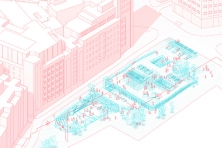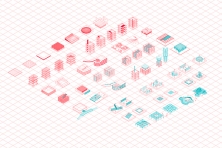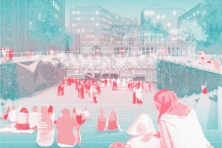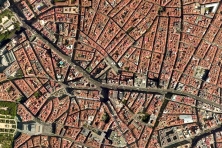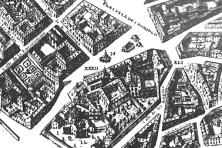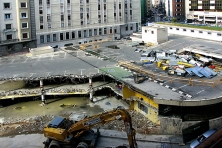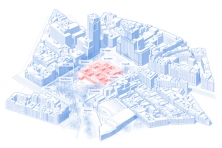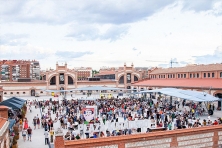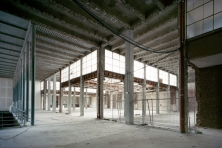Common Ground
Madrid (ES) - Mentionné
DONNÉES DE L’ÉQUIPE
Représentant d’équipe : Diego Martín Sánchez (ES) – architecte
Associée: Noemí Gómez Lobo (ES) – architecte
402, 3-14-14 Shimomeguro, Meguro-ku, Tokyo (JP)
+81 7044091043 – hola@furiistudio.com – furiistudio.com
Voir la liste complète des portraits ici
Voir la page du site ici

D. Martín Sánchez et N. Gómez Lobo
INTERVIEW en anglais
Cliquer sur les images pour les agrandir
1. How did you form the team for the competition?
We met at the School of Architecture of Madrid in 2011 and have been working together since then. Now that we are based in Tokyo, we felt that this was a good opportunity to intervene in the city where we became architects.
2. How do you define the main issue of your project, and how did you answer on this session main topic: the place of productive activities within the city?
The study area is located in the very centre of Madrid, which is recently suffering from an identity deterioration due to an increasing focus in tourism and commerce is pushing out the neighbours. The main issue for us was how to re-appropriate the obsolete public infrastructures such as the underground parkings below the proposed six squares. Understanding productivity not only from a functionalist and efficient point of view but also as an issue that needs to be regarded from a social perspective, we presented a map of the civic tissue of the area. These resilient spaces make Madrid more livable enabling reproductive activities such as caring, repairing or educating.
3. How did this issue and the questions raised by the site mutation meet?
Just in the central district, 22 out of 47 squares have underground parking. Considering this common characteristic as a resource that does not belong anymore to the car but to the citizens, an intervention in three stages is proposed in order to regain this public owned spaces. All the activities related to the public services and community conform the reproductive fabric. The squares are the core of this network. Behaving as catalyst for the rest of the neighbourhood, they give visibility to the core activities, injecting the uses that the neighbours demand.
4. Have you treated this issue previously? What were the reference projects that inspired yours?
The proposal presented here is the crystallisation of previous research that we have been developing. First on one of our thesis projects and afterwards with the proposal for the competition of Plaza de España in Madrid. We are interested in the transformation of the obsolete public infrastructures in the city. Since the turn of the century, several successful cases have spread in numerous cities like the High Line in New York, Le Palais de Tokyo in Paris or Matadero in Madrid. But this proposal would be the first example of adapting an underground parking into a habitable public infrastructure through the strategic subtraction of its elements. Also we are interested in gender urbanism. An inclusive approach to the city, that relies on diversity to the detriment of the generic city.
5. Urban-architectural projects like the ones in Europan can only be implemented together with the actors through a negotiated process and in time. How did you consider this issue in your project?
Being designed for the car, the parking is a typology that has very specific architectural features. Regarding this, potential operations are suggested in order to enable basic habitability conditions such as light and ventilation, giving spatial quality. This operational set aims to be a bottom up tool for negotiation with citizens, municipality and other actors. Not being a close solution but different ways to “hack” the parking, going from car architecture to people architecture. Again, understanding productivity from a social point of view, the most sustainable space is the one that is used intensively. In that sense, we propose an open aggregation of possibilities for the new infrastructure. Publicly managed, it can incorporate concessions, rents and programmable spaces by citizens that will be in constant readjustment.
6. Is it the first time you have been awarded a prize at Europan? How could this help you in your professional career?
This have been the first time that we have participated at Europan. We think that this competition is the perfect framework to test ideas and get valuable feedback that encourages young professionals to keep on going.
